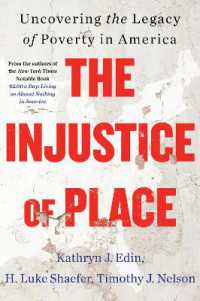- ホーム
- > 洋書
- > ドイツ書
- > Humanities, Arts & Music
- > Linguistics
- > english linguistics
Full Description
Confronting Toxic Rhetoric contributes to the extant scholarship on toxic rhetoric, specifically the negative and extreme political discourse surrounding the Trump years of campaigning, rallying, tweeting, holding office, and the ongoing culture war in the US (Duffy, 2020). Toxic rhetoric challenged the foundational purposes of teaching writing and rhetoric, such as ethical argumentation and critical thinking. Teachers' narratives, case studies, and reflections bring to light the ruptures, resistance, and resilience of teaching amid the extreme polarization of partisan politics, distrust of science, and increased hate speech, among other issues associated with toxic rhetoric.
Readers will learn from teachers who were challenged to cope with toxic rhetoric, using both rhetorical and extra-disciplinary lenses. Their experiences present a vulnerable yet resolved expression of coping, activism, and belief in the future of rhetoric and democracy.
"Toxic rhetoric is the proverbial fly in the soup of our political and public discourse, poisoning our politics, and by extension, our classrooms. Confronting Toxic Rhetoric takes up the arduous task of treating the contamination in our classrooms while encouraging us to advance the work of decontamination in our broader rhetorical ecosystems."
—Ryan Skinnell, Editor of Faking the News: What Rhetoric Can Teach Us About Donald J. Trump
Contents
Acknowledgments - Jamie White-Farnham: Confronting Toxic Rhetoric Prelude: Origin Stories of Toxic Rhetoric - Jamie White-Farnham/Cathryn Molloy/BrynaSiegel Finer: Introduction - Whitney Jordan Adams: Site of Contention: Rhetorics of/and Stone Mountain, Georgia - Craig A. Meyer: When Two Sides Are Too Many: Using Fairness in Unfair Ways - MatthewBoedy: Taking on Toxic Rhetoric in the Classroom - Liping Yang: From "Kung Flu" to #StopAAPIHate: Confronting Toxic Anti-AAPI Rhetoric through Contemporary Activism and Digital Literacy - Sarah Lonelodge: Responding in Real Time: A Course in Rhetoric, Propaganda, Demagoguery, and Misinformation - MirandaL. Egger: Social, Digital Annotation as a Tool for the Future of Democratic Discourse - Bruce Bowles Jr.: "The Action is on You!": Examining When and Why to Engage—or not Engage—Rhetorically - Charles McMartin: Teaching Toward Coalitions: Combating the Toxic Rhetoric Around Critical Race Theory and Diversity, Equity, and Inclusion - Sarah M. Shea: The Elephant in the Room: On Responding to Potential Toxic Rhetoric in Tutoring Sessions - Daniel Cole: Detoxifying Debate: Confluences of Composition and Conflict Resolution - Postscript: (Re)Calling the Character of a Career: A Letter of Thanks to John Duffy by Rachel Ketai - Notes on Contributors - Index.







